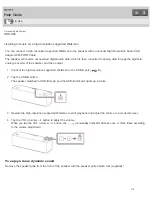
Personal Audio System
SRS-X99
About High-Resolution Audio format files
High-Resolution Audio, which is typically 96 kHz/24 bit or higher, is made by digitally sampling an original analog audio
source. The number of times at which sampling is performed (in one-second increments) is called the sampling
frequency, which is expressed in hertz or “Hz”. Digitizing refers to the audio process where the sampled signal is
converted (or quantized) into binary digits, consisting of 1's and 0's, and expressed as “bits”. The higher the number of
bits, the closer the sample is to the original source. CDs are standardized at 44.1 kHz/16 bit, but there is no single
standard for High-Resolution Audio.
An alternative way of digitizing an analog source is a method called DSD (Direct Stream Digital) which captures sound
information as a sequence of single bit values with an extremely high sampling rate of either 2.8 MHz or 5.6 MHz. This is
approximately 64 or 128 times the sampling rate of CD audio and is simply known as DSD 2.8 MHz or DSD 5.6 MHz.
For some engineers, this is the closest a digital file sample can get to an original analog source.
4-567-508-11(1)
Copyright 2015 Sony Corporation
How to Use
112
















































